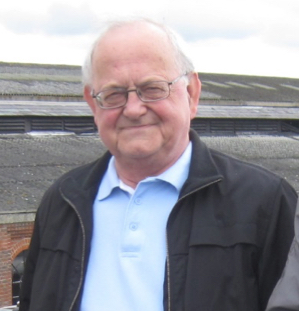 Peter TaylorLifelong St Albans City supporter Peter Taylor was one of the handful of people responsible for the database of City statistics available through this statistics & history website, as well as the club website.
Peter TaylorLifelong St Albans City supporter Peter Taylor was one of the handful of people responsible for the database of City statistics available through this statistics & history website, as well as the club website.
During our research we came across a large number of photographs and one of the tasks that Peter enjoyed doing was to breathe new life into some of them by colourising them. The end results were fascinating, maybe not always totally accurate but they give a new perspective to players and games from a bygone era.
Sadly, Peter passed away suddenly in August 2019 but this collection of colourised photographs is another part of the legacy that he has left behind for others to enjoy.
1891-92
The oldest photo that Peter turned his hand to for colourising was the 1891-92 team photo of the original St Albans. At this time the club was playing its home games at the Grammar School Ground that is better known these days as Belmont Hill, but is now buried under a housing estate.
As with all of the photos in this section Peter has used a bit of artistic licence so, particularly with these much older ones, there may be some variation from the true colours.
The two most colourful characters in the photo have taken centre stage in the middle of the bench. On the left is James William Dickson and, on the right, the magnificently named Sandford Ffolliat Pierpoint Moore. Dickson studied law at Exeter College, Oxford. The colours for which on the crest are gold, black and white, rendering the colours in this photo as possibly unlikely. Prior to going to Oxford Dickson had been a pupil at St Albans Grammar School and it was on their football pitch that he now turned out for St Albans. Sandford Moore, born in Lyme Regis, was a music master at St George’s School, Harpenden, and was a phenomenal goal scorer. He scored a known 96 times for the original club but the actual figure is probably higher due to a number of match reports in which the goal scorers were not noted.
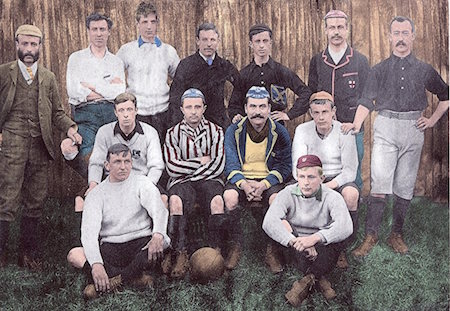 | 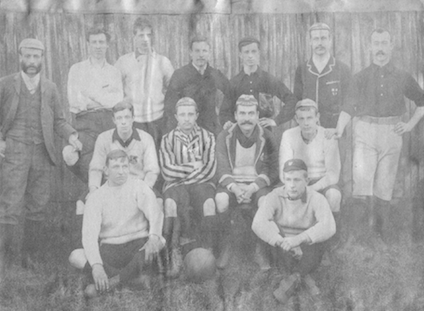 |
To the left of the middle row is John William Sharpe who has the Stag of Hertfordshire on his jersey. Sharpe had played for the county by this time, as had Moore, Dickson, and the Rev. Charles Bennett. Quite why Bennett has the flag of St George on his breast pocket is unclear. Third from the right in the back row is Ernest Northern Sharpe, he is only player bearing in the flag of St Albans (assuming that Peter has got the colours correct). Nothing has been unearthed thus far to suggest that the football club had the City shield on their kit.
It would seem reasonable to suggest that the photograph was taken at Belmont Hill although it is also possible, though unlikely, that it was taken in the grounds of The Crystal Palace public house that stood in London Road. The landlord of the Crystal Palace is the gentleman to the left of the back row, Fred Gentle. Since its formation in 1881 the club had used the Crystal Palace as its headquarters.
1908-09
This photograph is a particularly important one in the history of St Albans City in that it is the earliest surviving action shot from one of our games. The venue is Bury Lane, Rickmansworth, where City popped in for a Herts County League fixture on 12th December 1908. The starkness of the trees on the far side of the pitch emphasise the point that the game was played in midwinter.
This was only the eighth competitive game played by the club and the fourth away game. To top the lot, goals by Tommy Walker and Leslie Hosier secured City’s first win on opposition soil.
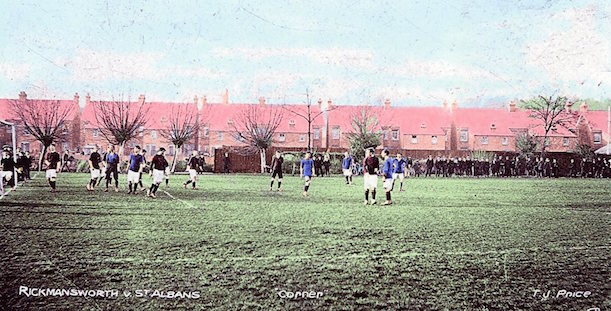 | 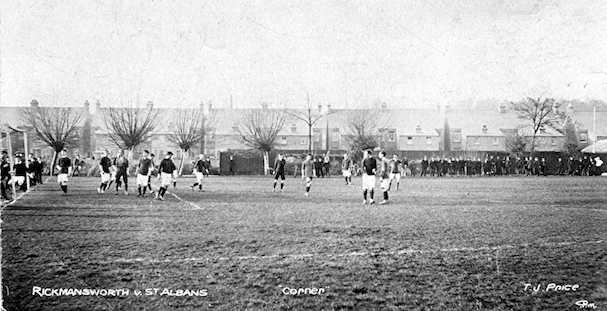 |
Assuming that Peter has coloured the teams correctly City are on the attack and the caption in the middle at the foot of the photograph states, ‘corner.’ The picture appeared on a postcard rather than as a normal photograph.
The football pitch at Bury Lane has long since gone with a dyke and allotments narrowing that stretch of land. The houses seen in the background are still in situ.
1911-12
A group photo of both the City First and Reserve teams taken in front of the cricket pavilion at Clarence Park allowed Peter an opportunity to experiment with how he perceived the colours to be. The two teams are each wearing a slightly differently designed kit and he emphasised that point by giving them a different colour. However, he does seem to have stretched the point by coming up with three variations.
The original black and white photograph does suggest that the two kits are of differing shades. When the club was formed five years earlier it was clearly stated that it would adopt the colours of the city, blue and gold. Quite how this was worked into the two kits is unknown.
The practice of taking team photographs in front of the pavilion at this time would almost certainly have been due to the pavilion being used as the players changing room. It was not until 1929 that the dressing rooms were built into the main stand within the football ground.
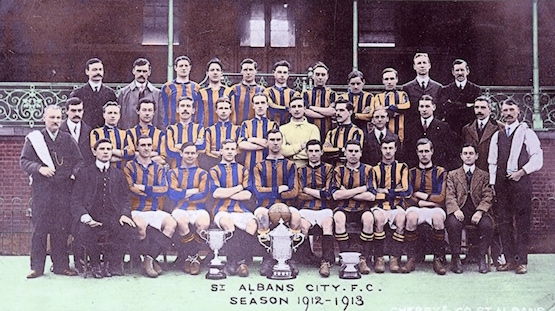 | 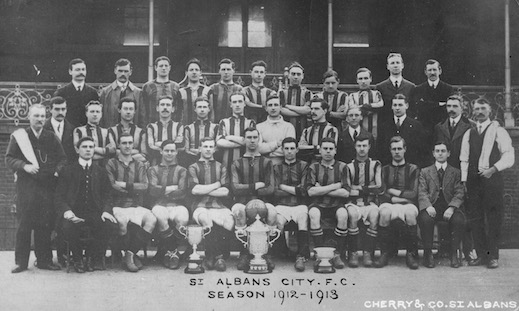 |
Putting a date on the photograph is not as straightforward as it maybe should be. The date written onto the football perched between the legs of Ernest Grimsdell states 1912-13. City, though, did not win the three cups on display in the same season. The trophy on the left is the Bingham Cox Cup and the one to the right is the Herts Charity Cup. Both of these were indeed won during 1912-13 but the middle pot, the Spartan League championship, was won in 1911-12. The Bingham Cox was won with a 3-2 victory over Sandridge at Clarence Park on Easter Monday, 24th March, this after trailing 2-0 at half time. It would appear that City did not have to return the Spartan League trophy until the end of the season, so it is likely that the two teams gathered at the Park for this photo on the date of the next home match after the final of the Bingham, 17th April, which was two days before the final game of the Spartan League season.
1913-14
The City Reserve team proudly display the Herts Junior Cup and Mid Herts League Championship shield in front of the Clarence Park cricket pavilion. The season had been the last before the outbreak of World War I. Jack Rainsden , who lived in Blacksmith’s Row in St Michaels, died at the Somme on 27th July 1916 and is seen second from the right in the middle row. At the right hand end of the front row is Charley Wiggs whose brother Arthur was also killed in France during the war.
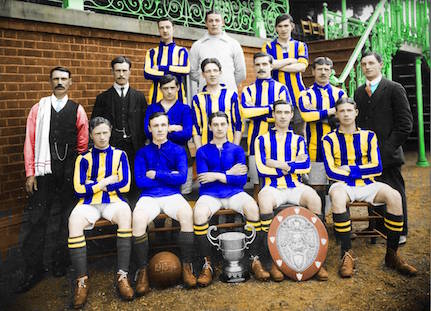 | 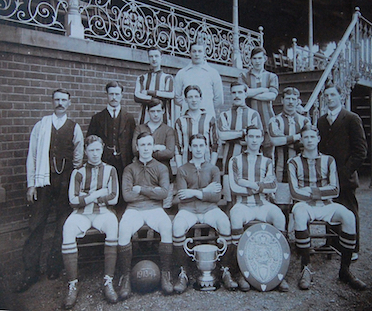 |
Peter Taylor’s choice of colours here are probably a bit on the bright side, certainly the ornate metalwork on the pavilion has seldom appeared more luxuriant. Trainer Fred Halsey also appears to be wearing a shirt that has a white body and pink arms, most fetching.
1921-22 Hertfordshire
Peter Taylor turned his hand to the county team with this photo that was taken at Top Field, Hitchin, just before Hertfordshire defeated Northamptonshire 4-0 in the Southern Counties Amateur Championship on the 5th October 1921. The day was described was described ‘boilingly hot.’
If this was indeed the kit that the players took to the pitch in, bearing in mind that Peter had full artistic licence when colourising this version, then one shudders at either the funds of the county F.A. at this time or the general organisation. Hertfordshire made it through to the final and played in a kit that looks remarkably like the St Albans City shirts of the era but, again, the shorts and socks seemed to be a collection of pick and mix items.
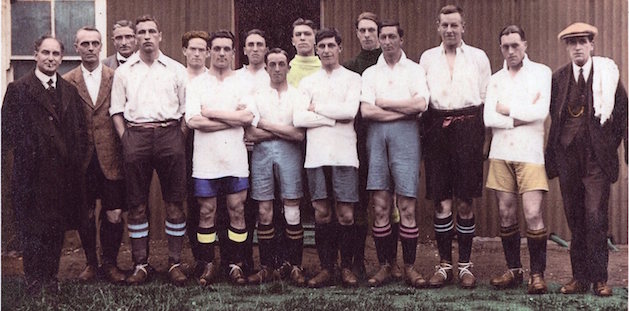 | 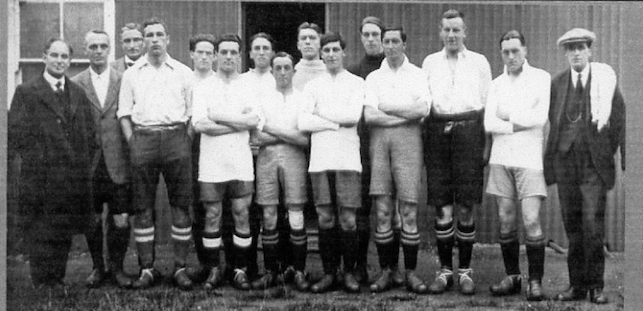 |
There was a strong St Albans City representation in the Hertfordshire side at Hitchin with four the team having roots at Clarence Park . Fifth from the left is Harold Figg, complete with his golden locks. In front of him is his City team mate Tommy Field and next along the line are Wilf Minter and Bertie Butcher, both of whom, scored in the game. Further along the line, fifth from the right, is the goalkeeper Cecil Canon who, at the time, was with Hitchin Blue Cross and joined St Albans at the start of the 1924-25 season.
1921-22
Four of the biggest games in the history of St Albans City were played during 1922 when we faced Dulwich Hamlet, firstly, in the Amateur Cup and, secondly, in the FA Cup. On both occasions a draw at Clarence Park was followed by victory for Dulwich at Champion Hill.
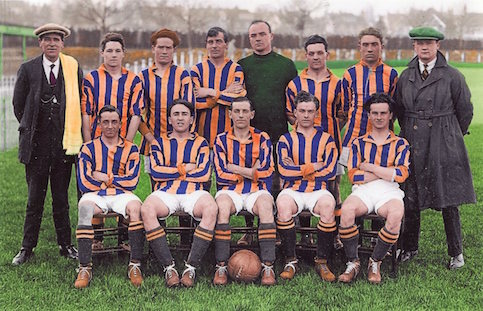 | small.jpg) |
Above is the City XI that drew with Dulwich on the 11th February 1922. City captain George Meagher is seated in the front row with the ball at his feet, at the left of that row is Bertie Butcher the scorer of both City goals in a 2-2 draw. The game attracted a new Clarence Park record attendance of 7,440.
After colourising the team line up from before the game Peter Taylor then brought new life to an action photo from the game. City’s New Zealand-born goalkeeper W. Innes Tennent dashes out to clear his lines as the Dulwich forward Edgar Kail closes in. Kail was not only an England Amateur international but also represented the Full England team. The two City players sandwichedbetween Kail and Tennent are Tommy Field and Percy Bird.
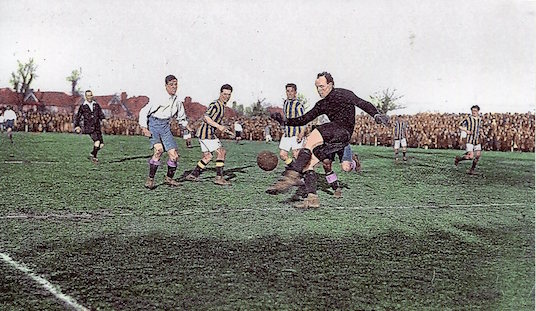 | 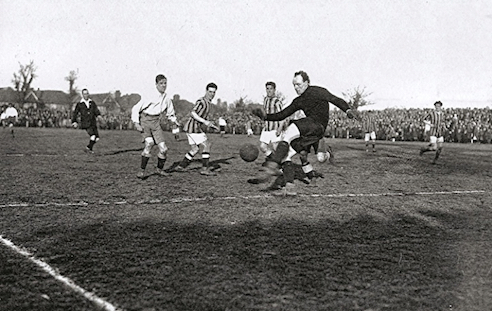 |
The large attendance can be seen banked around the edge of the pitch, such a sight would not have been possible up until just before Christmas. At that time asphalt from the running track around the cricket pitch was used as a base for railway sleepers that formed the first terracing at the football ground.
Dulwich won the replay 3-1 to become the first amateur side to beat St Albans since New Year’s Day 1920. The attendance at the replay was announced as 10,800 but it is believed that possibly more than 3,000 people forced their way in once the gates were locked.
1922-23
On the occasion of the Amateur Cup semi-final with London Caledonians at Kenilworth Road on the 17th March 1923, St Albans City posed for a team photograph. A game lay ahead and the players were about to perform in front of the biggest crowd of their football careers, 13,950. The faces in the back row give a sense of the occasion, the look is pensive. Fred Hellicar, furthest to the right, appears almost disdainful. To his right, the long serving George Meagher looks decidedly shifty. Yet, by contrast, the five forwards seated on the bench appear far more relaxed, some even hinting at a smile. Sadly, City did not play up to their usual standard and were seen off quite comfortably 2-0.
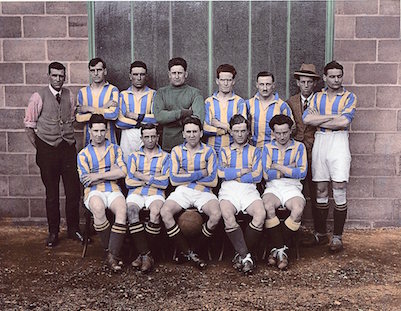 | 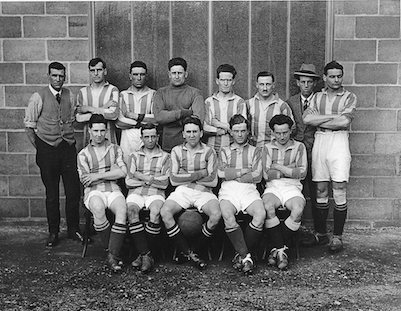 |
Peter Taylor’s colourisation brings new life to various aspects of the photo. The boots of the players at the front are gleaming, particular Wilf Minter’s. The two Miller brothers, Ted and Redvers, seem to have socks that are different in design to those of their team mates. And Peter has added an almost bronze finish to the hair of Harold ‘Ginger’ Figg.
Hayes 1-3 St Albans City - Amateur Cup 1st Round. 17thJanuary 1948
This wonderful photo from City’s first visit to Church Road was next to catch Peter Taylor’s colourising eye. The City mascot, 9-year-old Eric Darby, heralds the entrance of the team that is led by skipper Gordon Wilkinson and goalkeeper Terry Gibbons.
Headwear is still strongly featured amongst the crowd, maybe not to the extent of the crowds seen during the 1920s but certainly more common than seen in later years. Clearly visible are the two benches for the coach and trainer to sit on, no substitutes in those far off days.
small.jpg) | bwsmall.jpg) |
City won 3-1 with goals from Dave Sayers 2 and Jimmy Sperrin (G.Patterson bagged the Hayes goal). The attendance was announced as 3,765 with a considerable contingent having made the short journey from St Albans. The Supporters Club booked 25 coaches to ferry supporters to the game and an official stated that ‘practically every taxi for miles around has been booked for the journey.’
1954-55 Dennis Wells
One of the all time wonderful action photographs from a St Albans City match sees Dennis Wells in full flight during City’s 1-0 win over Bromley at Hayes Lane on 2nd April 1955. City finished the season as runners up in the Isthmian League and the win at Bromley proved crucial to seeing Bromley nudged down to third place.
 | 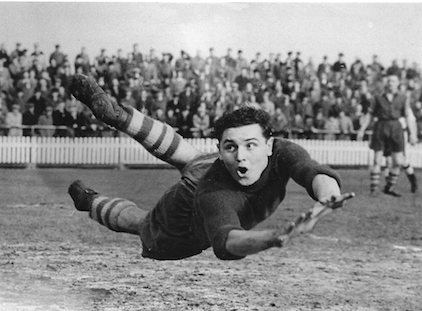 |
Dennis, who emigrated to New Zealand many years ago, turned 86 on the 12th May 2020.
1950-51 Hitchin Town 0-3 St Albans City - Herts Senior Cup Final. 5th May 1951
In somewhat exaggerated blue and gold colours City celebrate winning the county cup for the first of four times during the 1950s. Captain Freddie Collings is hoisted shoulder high by his delighted team mates after two goals from Johnny Richards and one by Jimmy Sperrin had seen off Athenian Leaguers Hitchin Town.
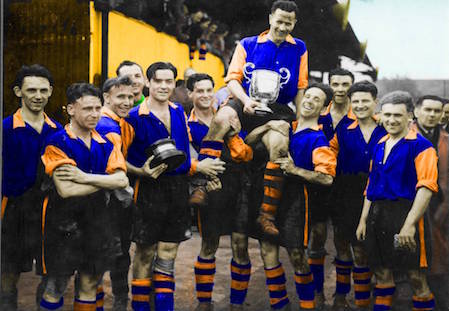 |  |
Running from left to right the players are;
Gerry Bishop, Jimmy Sperrin, Harry Rawlings, Jim Trueman, Fred Collings, Jimmy Meadows, Gordon Wilkinson, Bill Hussey, Johnny Richards, Bill Saunders , Johnny Croucher.
1968-69
One of the more memorable City kits that could only have been improved upon with the addition of the club crest, which as this time was the simple cross as the full coat of arms was not adopted by the St Albans City & District Council until 1974.
small.jpg) |  |
The design was simple yet stylish. As befitting a great kit it is worn here by some of the greatest players to turn out for the club. This was the season that the club reached the 2nd Round of the FA Cup and a year later many of the same squad progressed to the semi final of the Amateur Cup and finished third in the Isthmian League.
Back: Dennis Gibbs, Mick Harman, Les Burgess , Ian Lomas, Dave Neville
Middle: Brian Francis, Bobby Childs, Phil Wood , Rill Ratty, John Butterfield, Ron Whiteaker
Front: Peter Spittle, John Mann, Dave Lawrence, Bill Broomfield, Paul White
1968-69 Boreham Wood 0-2 St Albans City - Herts Senior Cup 3rd Round. 25thJanuary 1969
With victory at Broughinge Road City moved a step closer to retaining the county cup. In this colourised photo Wood ‘keeper Jim Noble flaps at a cross as City’s centre half Les Burgess goes close with a header, no.9 John Butterfield looks on. Butterfield got his name on the scoresheet, our other goal came courtesy of Bill Broomfield.
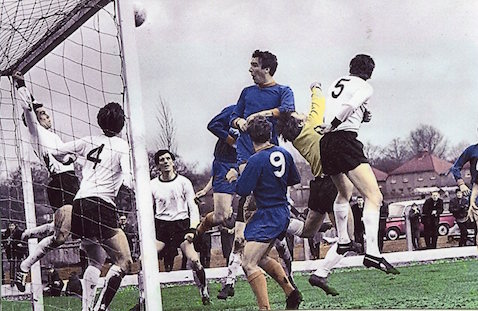 | 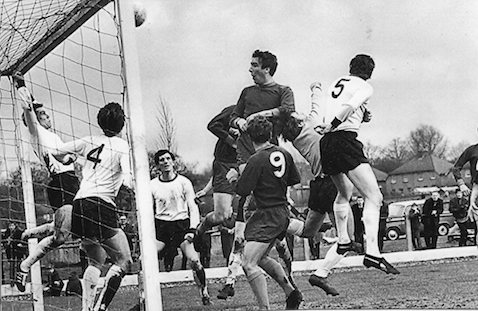 |
The Wood manager at this time was Mickey Hunter. In the background is a view of Wood’s Broughinge Road ground that was to change substantially during the 2010s under the guidance of chairman Danny Hunter, son of Mickey.
The attendance of 864 was Wood’s highest of the season.
1951 Supporters Club Outing
Peter Taylor let his artistic skills and coloured crayons run wild with this one. The photograph was taken outside The Fortune of War hotel on the A127 in Laindon, Essex. (The hotel replaced an older pub in 1925 and closed its doors for the final time in 2003 before disappearing under a housing estate).
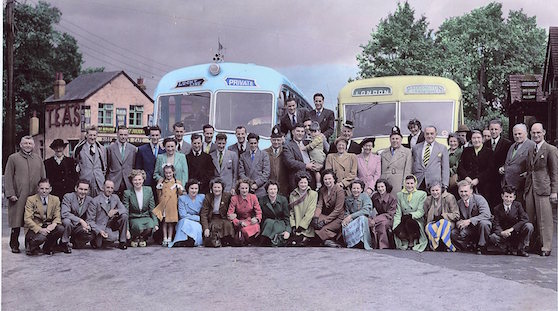 | 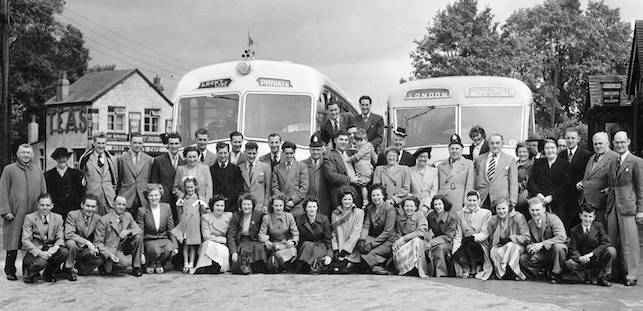 |
The party is believed to be a collection of St Albans City club officials, players and their respective partners. Bertie Butcher, third left front row, is clearly visible but should anyone be able to add other names then please get in touch via the website.
Harold Figg and Wilfred Minter
Two of the greatest names to feature in the history of St Albans City, Figg and Minter spearheaded the success of the club in the 1920s that has never come close to being matched since. Minter was an Amateur international with England, Figg should have been. Both turned down offers to turn professional with the leading clubs of the era, yet, in these photographs, both appear unassuming and indeed maybe frail.
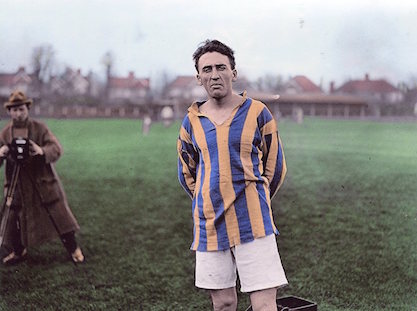 | 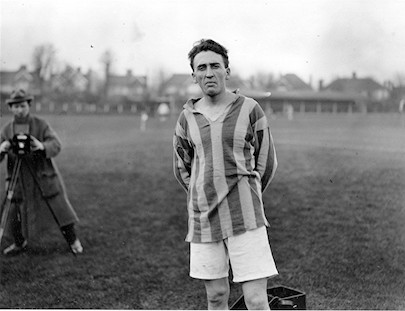 |
Wilf, or Billy as he is better known, is in the classic St Albans City shirt of blue and gold stripes. The photograph was taken on the cricket pitch in Clarence Park with York Road in the background. Photographs from City matches at this time are rare, so to have two photographers taking pictures of Wilf is something of a luxury. The dramatic pose of the photographer seen here almost gives the picture the feel of it being on a Hollywood film set. As for Minter, he looks almost dishevelled and could easily have passed for being someone in their mid-40s rather than mid-20s. His shirt appears creased and the neck wayward, but with 356 goals in 362 games for St Albans City no one will criticise his apparent lack of sartorial elegance.
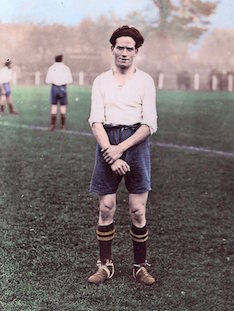 | 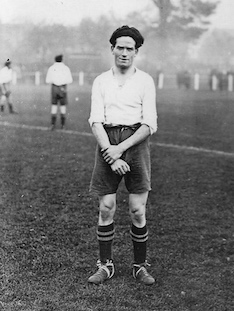 |
Quite inexplicably, during the mid-1920’s St Albans City changed from their traditional kit of blue and gold, the colours of the city, to one of black shorts and white shirts. Even before making the change City had worn, on occasion, white shirts and blue shorts, as demonstrated here by Harold Figg, to avoid a clash of colours with opposing sides.
As with Minter, Harold, known as ‘Ginger,’ does not suggest from this photograph just what a formidable opponent he was from his half-back (midfield) position. With his puffed -up hair he looks almost top heavy.
The kit appears, at best, functional but possessing neither style nor elegance. Those qualities were supplied by the quite wonderful footballer inside them.
Harold Figg scored 56 times in 370 games for St Albans City before going on to serve on the committee of the club.
Harry Rawlings
Harry Rawlings just missed out on reaching a landmark during his three years at Clarence Park . Joining St Albans City from Enfield in February 1949 he went on to make 99 appearances at left back before leaving the club at the end of the 1951-52 season.
Here, Harry models a shirt that is as true as the club could have been in going along with adopting the colours of city. Harry, who passed away in July 2000 at the age of 81, is the only player to have played 99 games and not gone on to reach 100 games before leaving the club.
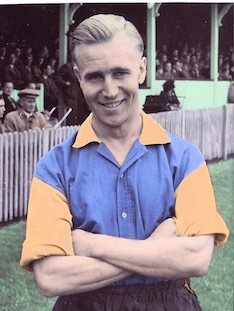 | 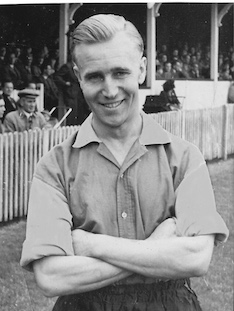 |
Peter Taylor’s colourising is interesting in a photo that highlights several points. He opted for the front of the stand being painted in lime green; it was probably white back then. It is interesting to see two prams in front of the stand. The pitch perimeter fence is wooden, as opposed to metal with a wire in-fill in later years, and people are seen sitting in front of the stand. Those closest to the fence are curious in that there was no fixed seating there. However, there are people to be seen seated just in front of the stand, they were on a bench that ran for the entire length of the stand and provided seating for 200 people.
John Butterfield
John Butterfield was Peter’s favourite City player and to colourise a photo of this true City great will have given him immense pleasure.
John worked with the ground staff at Lord’s and could have been a county cricketer before throwing in his lot with St Albans City. He went on to play for the England Amateur team, 19 caps, and appeared for Ilford at Wembley in the last Amateur Cup final in 1974; forsaking cricket for football probably didn’t work out too badly for him.
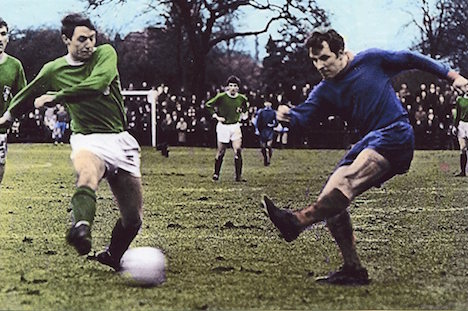 | 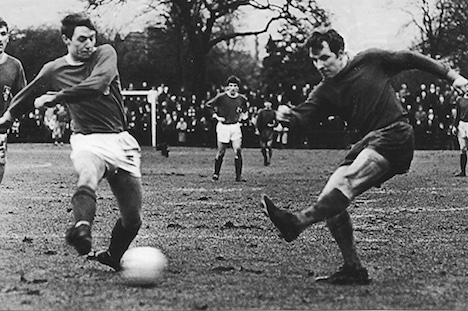 |
‘Butts’ scored 176 times in 374 games for the City, only Wilf Minter and Steve Clark scored more times than him.
Some of the biggest games during his time at Clarence Park were against Hendon, this photograph is taken from one such encounter.
